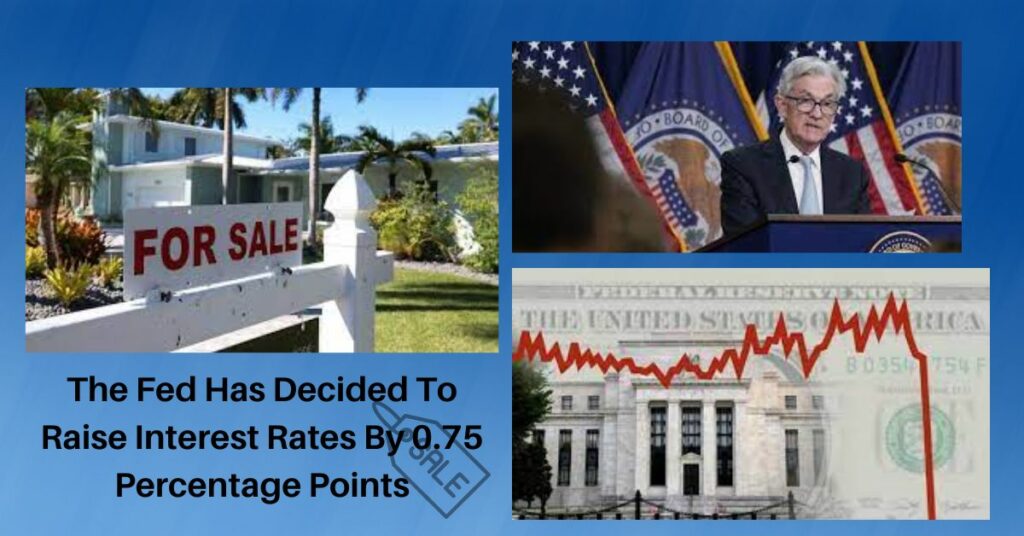In order to slow down important aspects of the economy and control inflation, which is at a 40-year high, the Federal Reserve announced Wednesday that it was increasing its short-term borrowing rate by an additional 0.75%.
The new goal range, according to the central bank, is 3.75%-4%, which is the highest level since January 2008.
You can also check
- China& s Central Bank Cuts Interest Rates: Deal With Slowdown In Lending
- Federal Reserve Raises Key Interest Rate By 75 Basis Point
The strong action is the most recent in a series of recent rises in borrowing costs imposed by the Fed as it attempts to reduce price increases by slowing the economy and stifling demand. However, the strategy runs the risk of sending the US into a recession and eliminating millions of jobs.
Furthermore, less than a week before the midterm elections, the fourth rate increase of 2022 takes place.
“Russia’s conflict with Ukraine is having a terrible impact on both people and the economy. Inflation is being further pushed upward by the conflict and its accompanying events, which is putting pressure on global economic growth. The Committee keeps a close eye on inflation risks “Fed representatives stated in a statement. The Committee believes that continuous target range increases will be necessary to achieve a stance of monetary policy that is sufficiently restrictive to bring inflation back to 2 percent over time.
Consumer prices rose 0.4% on a seasonally adjusted basis in September, according to data released last month, despite efforts to keep prices down. Over the past year, which ended in September, consumer prices overall increased by 8.2%, beating economists’ expectations.
According to a Bloomberg survey of analysts, the Federal Reserve is anticipated to increase the benchmark interest rate by 0.75%, maintaining the increase it imposed at each of the previous three meetings. The Fed hadn’t matched a raise of this size since 1994 before this year.
Jerome Powell, the chair of the Federal Reserve, has reaffirmed the central bank’s commitment to bringing inflation down to a target rate of 2% on numerous occasions, stating that the Fed intends to propose “ongoing hikes” to its benchmark interest rate in September.
According to government data released last week, the personal consumption expenditures price index, the inflation gauge the Fed prefers, has a year-over-year rise rate of 5.1%.
According to Anne Villamil, an economist at Iowa University, “Powell has been very clear that inflation is unacceptably high and we have to continue the course to get it down.” Markets have been slightly optimistic that there would be a respite, but I don’t see that occurring.
Despite ongoing inflation, mounting evidence points to some economic activity being slowed down as a result of the Fed’s actions. As the United States continues to experience a downturn in home sales and housing building, mortgage rates last week reached a 20-year high.
Although it has continued to grow at a rapid rate, job growth has begun to slow down.
In September, U.S. firms created 263,000 new jobs, and the unemployment rate decreased slightly from 3.7% to 3.5%, exceeding expectations and highlighting the labour market’s ongoing strength.
However, the total was much below the average number of jobs added in a given month in 2022. According to the Department of Labor, there has been an average monthly increase in jobs of 420,000 this year as opposed to 562,000 per month in 2021.
You can also check
- China& s Central Bank Cuts Interest Rates: Deal With Slowdown In Lending
- US Consumer Price Index For September
Meanwhile, according to official data issued on Tuesday, both hiring and firing decreased marginally in September, indicating that companies’ demand for workers has started to decline. However, there were more job opportunities in September, indicating that there is still a need for labour.
A government assessment published last month indicated strong economic growth over the three months ending in September, despite the fact that certain data suggests an economic decline. The United States’ gross domestic product increased 2.6% at that time, although economic activity decreased 2.2% overall over the first half of the year.
Final Lines:




